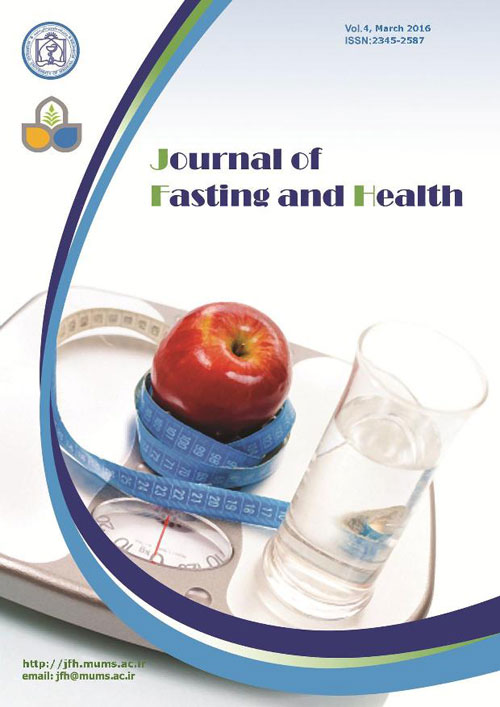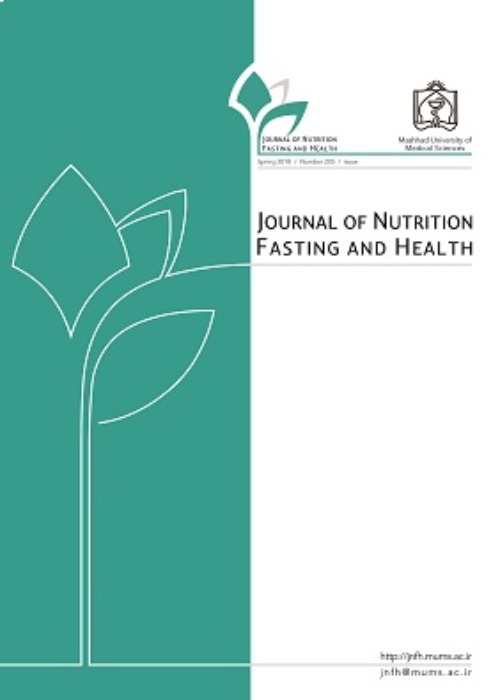فهرست مطالب

Journal of Nutrition, Fasting and Health
Volume:4 Issue: 1, Winter 2016
- تاریخ انتشار: 1394/01/08
- تعداد عناوین: 8
-
-
Pages 1-16IntroductionMetabolic syndrome constitutes a cluster of risk factors such as obesity, hyperglycemia, hypertension, and dyslipidemia, which increase the risk of cardiovascular diseases and type II diabetes mellitus. In this review article, we aimed to discuss the possible effects of fasting and regular physical activity on risk factors for cardiovascular diseases.MethodsOnline databases including Google Scholar, SID, PubMed, and MagIran were searched, using the following keywords: training, exercise, physical activity, fasting, Ramadan, metabolic syndrome, fat percentage, blood pressure, blood sugar, cholesterol, triglyceride, and lowdensity lipoprotein cholesterol. All articles including research studies, review articles, descriptive and analytical studies, and ross-sectional research, published during 2006-2015, were reviewed. In case of any errors in the methodologyof articles, they were removed from our analysis.ResultsBased on our literature review, inconsistent findings have been reported on risk factors for metabolic syndrome. However, the majority of conducted studies have suggested the positive effects of fasting on reducing the risk factors for metabolic syndrome.ConclusionAlthough fasting in different seasons of the year has no significant impacts on mental health or physical fitness, it can reduce the risk of various diseases such as cardiovascular diseases. Also, based on the conducted studies, if individuals adhere to a proper diet, avoid excessive eating, drink sufficient amounts of fluids, and keep a healthy level of physical activity, fasting can improve their physical health.Keywords: Fasting, Metabolic syndrome, Exercise, Ramadan
-
Pages 17-21Ramadan is a holy month for Muslims and fasting in this month is the rule for any healthy matured person. Nutritional and behavioral changes occurred during Ramadan fasting may lead to several physiological change, such as blood pressure (2). Studies evaluated the effects of Ramadan fasting on blood pressure in hypertensive patients, are scarce and reported inadequate results. In this paper a systematic review was performed to accumulate the results of published literature designed to evaluate blood pressure changes in hypertensive patients due to Ramadan fasting. All prospective, English studies which evaluated the effects of Ramadan fasting on blood pressure in hypertensive patients and measured systolic and diastolic blood pressure twice at least ( before Ramadan and during last week of Ramadan or after Ramadan fasting ) were included in systematic review .
Five studies reported the effect of Ramadan fasting on blood pressure in hypertensive patients in full text.
Although significant reduction in systolic blood pressure during Ramadan fasting were seen in 3 studies (3-5), other 3 studies reported no significant difference between systolic blood pressure before and after Ramadan fasting (6, 7). Among 6 studies that reviewed in this paper, 4 studies reported no significant changes in diastolic blood pressure (4, 6, 7). While 2 other studies reported significant reduction in systolic blood pressure after Ramadan fasting (3, 5).
This systematic review suggested that Ramadan fasting can be safe in treated essential hypertensive patients with continuation of previous medications. Also it can improve systolic and diastolic blood pressures.Keywords: Ramadan, Fasting, Blood pressure, Heart rate -
Pages 22-24Ramadan fasting is an important pillars of Islam .although patients and children expected from fasting during Ramadan, but every diabetic adolescents intends to fast should consult his diabetes management time, and intensive monitoring of blood glucose and urine ketones .close observation by endocrinologist, and weekly follow- up and highly individualized planning for each diabetic person is essential. In this Article we described general role that should be considered by type 1 diabetic people if they want to be fast during Ramadan.Keywords: Diabetic patients_Ramadan fasting_Type 1 diabetes
-
Pages 25-31IntroductionIn Ramadan, healthy adult Muslims are obliged to fast. Prolonged fasting increase gastric acid and pepsin levels, which promote the risk of duodenal ulcer perforation (DUP). Effects of Ramadan fasting on DUP have not been thoroughly studied yet, and the limited number of studies investigating the impact of Ramadan fasting on DUP yielded discrepant results. This study aimed to evaluate DUP frequency during Ramadan 2011-2015 and compare it with other months.MethodsThis cross-sectional study was performed in 82 patients undergoing surgery due to DUP during July 2011-September 2015. The demographics, history of addiction, use of nonsteroidal and antiinflammatory drugs, previous history of acid peptic disease, as well as complications and outcomes of treatment were recorded and analyzed, and the obtained results were compared between Ramadan and other lunar months.ResultsThe majority of patients were male (86.6%, 71 patients), with a mean age of 43.9±16.5 years (age range: 20-75 years). Male to female ratio was 6:1. Cases with less than 30 years of age were less frequent (22%, 18 patients). DUP was more frequent during Rajab with nine cases (11%), while during Ramadan, six cases were reported, the difference between Ramadan and other months regarding the incidence of DUP was not significant (P=0.7). Risk factors such as smoking (60%) and addiction (44%; especially to crystal and crack) were noted. Consumption of nonsteroidal antiinflammatory drugs in 20 (24%) patients, and use of antacids in 17 (25%) patients. Distribution of DUP in different blood types was as follows: O=41%, A=28%, B=23%, AB=5%, and O-=3%; moreover, post-operative Helicobacter pylori antibody was present in 67% of the patients.ConclusionRamadan fasting did not escalate DUP incidence, and those with DUP risk factors can fast with the use of antacids.Keywords: Acute abdomen, Duodenal ulcer perforation, Ramadan fasting, Duodenal repair
-
Pages 32-37The month of Ramadan, as a model of intermittent fasting, is a valuable opportunity to investigate the effects of dietary modifications on human metabolism. Fasting improves insulin sensitivity, reduces atherogenic risk, oxidative stress, and inflammation. Inflammation plays a key role in the pathogenesis of different disorders including atherosclerosis, metabolic syndrome and cardiovascular diseases. Ramadan fasting can positively modulate cardiovascular risks and improves the metabolic syndrome features through suppression of inflammatory responses. In this review we attempt to present recent studies that addressed the regulatory role(s) of this nutritional status on inflammation in patients with inflammatory diseases. These studies suggest that the anti-inflammatory effect of fasting is significant and could be considered as a complementary therapeutic approach in treatment of inflammatory disorders in patients.Keywords: Ramadan fasting, Inflammation, Metabolic syndrome, Cardiovascular disease
-
Page 38The 17th Congress of Parenteral and Enteral Nutrition Society of Asia (PENSA 2016) and the first Symposium on Fasting and Health will be held on 6th to 8th December 2016 at Olympic Hotel, Tehran, Iran. The congress is hosted by Tehran University of Medical Sciences, Semnan University of Medical Sciences and Scientific Committee of Iranian Nutrition Society. This congress is organized with the partnership of Mashhad and Kermanshah Universities of Medical Sciences, Journal of Fasting and health, Nutrition and Health technology Assessment (HTA) Departments in Iran Ministry of Health and Medical Education as well as National Nutrition & Food Technology Research Institute (NNFTRI). The 17th congress of PENSA presents the first symposium on "Fasting and Health", which includes all relevant research reports about fasting and its effects on human health, fasting and diseases and update guidelines related to fasting. Dr. Nematy who is chairperson of Journal of Fasting and Health is the manager of this symposium and several experts from different countries are co-chairpersons. Accepted abstracts in the symposium will be published in winter issue of Journal of Fasting and Health.Keywords: Congress, Parenteral, enteral nutrition, Asia, Tehran
-
Pages 39-47Aim: was to assess the effects of Ramadan observance upon repeated sprints and associated inflammatory and oxidative stress responses.MethodsTen young trained boxers were tested during a control period (C), at the end of the first week (R-1), and during the fourth week of Ramadan observance (R-4). On each occasion, they performed three vertical jumps, 10 x 6 s repeated sprints on a cycle ergometer, followed by three final vertical jumps 1 min after. Surface electrodes measured the EMG activity of the vastus lateralis during jumps performed before and after sprinting. Oxidative stress (malondialdehyde, total antioxidant and catalase), inflammatory markers (C-reactive protein, Interleukin-6 and homocysteine), muscle damage (CPK and LDH) and blood glucose were measured at rest and after completing the exercise protocol.ResultsThe overall sprint performance was reduced at R-1 compared to C (-6.3 ± 1.2%, p = 0.025), but had recovered by R-4. Jump height decreased after the repeated sprints (pConclusionThe correction of sprint performance may highlight some adaptive responses to fasting. The unchanged of the selected fatigue biomarkers after the repeated sprint protocol suggest that the dietary restriction related to Ramadan is not severe enough to induce significant changes in the metabolism of our trained athletes.Keywords: Anaerobic power, Antioxidant status, Electromyography, Fatigue, Proinflammatory enzymes
-
Pages 48-52Ayurveda, the Indian art of holistic medicine describes fasting in terms of Upavasa and considers it as one among the depletion therapies. Besides the extensive explanations on the preventive purports of fasting, the classics have explicitly explained and exemplified the therapeutic importance of fasting while treating different diseases and dealing with different stages of the diseases. Fever, eye disorders, diarrhoea, nasal disorders, vomiting, gastroenteritis are a few diseases elucidated, where fasting plays a pivotal part. Ayurveda acknowledges the aspect that fasting brings about the digestion of the metabolic toxins, kindles the digestive fire, removes the blockage in the channels and there by aids in minimizing the disease. And also, the stage/ intensity of the diseases [mild/moderate/maximum] is of great importance to modulate the manner of fasting; either solely or stringed along with the required therapeutic procedures. The duration of fast depends upon the dosha involved; it is longer in Kaphaja disorders and shorter in those due to Vata dosha.The classics have elaborately and exceptionally explained the signs and symptoms of adequate, excess and inadequate fasting along with the contraindications during the execution of fasting, with a view to aid the physician administer apt and accurate treatment and thereby help the individual attain perfect health. The concept and canons of fasting are so very much incorporated and interlaced in the vast science of Ayureda that it advocates, acknowledges and admires depletion therapy, which includes Upavasa / fasting, as the best treatment modality a physician should adopt, by stating, langhanam paramoushadam.Keywords: Ayurveda, Diseases, Depletion, Fasting, Therapeutic


